Test Level 1: Critical Path - CAT MCQ
20 Questions MCQ Test Level-wise Tests for CAT - Test Level 1: Critical Path
Directions: Study the following information and answer the questions that follows.
Seven playrooms (P1, P2, P3, P4, P5, P6 and P7) of a play-way school are connected to each other through different routes. Distances between these playrooms are shown with the help of a diagram. All the students first go for assembly, which will be held in the main hall, that is P1.

What could be the shortest distance a child needs to cover if he wants to go from P4 to P7?
Seven playrooms (P1, P2, P3, P4, P5, P6 and P7) of a play-way school are connected to each other through different routes. Distances between these playrooms are shown with the help of a diagram. All the students first go for assembly, which will be held in the main hall, that is P1.

Directions: Study the following information and answer the questions that follows.
Seven playrooms (P1, P2, P3, P4, P5, P6 and P7) of a play-way school are connected to each other through different routes. Distances between these playrooms are shown with the help of a diagram. All the students first go for assembly, which will be held in the main hall, that is P1.
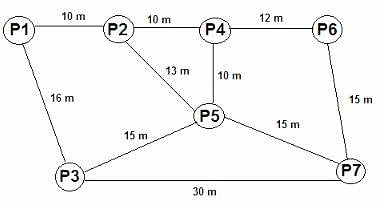
What could be the longest possible route from P4 to P3?
Seven playrooms (P1, P2, P3, P4, P5, P6 and P7) of a play-way school are connected to each other through different routes. Distances between these playrooms are shown with the help of a diagram. All the students first go for assembly, which will be held in the main hall, that is P1.

| 1 Crore+ students have signed up on EduRev. Have you? Download the App |
Directions: Study the following information and answer the questions that follows.
Seven playrooms (P1, P2, P3, P4, P5, P6 and P7) of a play-way school are connected to each other through different routes. Distances between these playrooms are shown with the help of a diagram. All the students first go for assembly, which will be held in the main hall, that is P1.
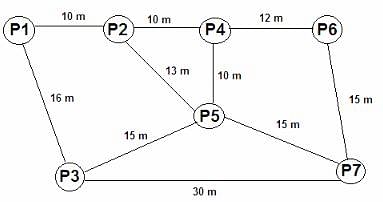
Which of the following routes would add up to a distance of 23 m?
Seven playrooms (P1, P2, P3, P4, P5, P6 and P7) of a play-way school are connected to each other through different routes. Distances between these playrooms are shown with the help of a diagram. All the students first go for assembly, which will be held in the main hall, that is P1.

Directions: Study the following information and answer the questions that follows.
Seven playrooms (P1, P2, P3, P4, P5, P6 and P7) of a play-way school are connected to each other through different routes. Distances between these playrooms are shown with the help of a diagram. All the students first go for assembly, which will be held in the main hall, that is P1.
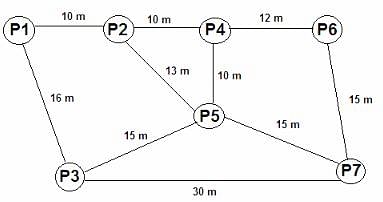
How many maximum number of playrooms does a child need to cross to go from P2 to P3, if he can go around any classroom just once?
Directions: Study the following information and answer the questions that follows.
Kiran, Piya and Amar are going to take a round of a city following different or same pathways. All of them can take any means of transportation (car, two wheeler, or public transport). Charges for all of them are different. They have to pay Rs. 200/hr, if they are taking a car on rent. While the charges for a two wheeler are Rs. 50/hr. However, they just need to pay Rs. 20 to go through a public transport for an hour. Their route will start from point K and will end at point P. O is the place where they can sit and relax. M, L and N are places to get different means of transport. M is the place where cars are parked. L is a bus stand, while at place N, two wheelers are parked. The charges of going to car parking, two wheeler parking or bus stand are fixed and are Rs. 30, Rs. 10 and Rs. 40, respectively. The different pathways are as follows and the distance between them is given in km.
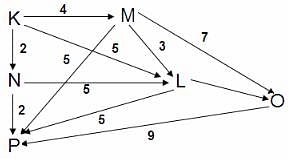
How much minimum distance does Kiran need to cover if she prefers to go by a car?
Directions: Study the following information and answer the questions that follows.
Kiran, Piya and Amar are going to take a round of a city following different or same pathways. All of them can take any means of transportation (car, two wheeler, or public transport). Charges for all of them are different. They have to pay Rs. 200/hr, if they are taking a car on rent. While the charges for a two wheeler are Rs. 50/hr. However, they just need to pay Rs. 20 to go through a public transport for an hour. Their route will start from point K and will end at point P. O is the place where they can sit and relax. M, L and N are places to get different means of transport. M is the place where cars are parked. L is a bus stand, while at place N, two wheelers are parked. The charges of going to car parking, two wheeler parking or bus stand are fixed and are Rs. 30, Rs. 10 and Rs. 40, respectively. The different pathways are as follows and the distance between them is given in km.
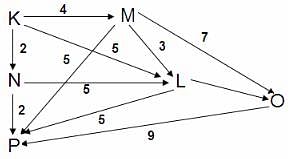
What amount does Amar need to pay in total, if he wants to travel through the route K-L-O-P and his whole journey takes three and a half hours in total whereas it takes half an hour to travel from the starting point till the bus stand?
Directions: Study the following information and answer the questions that follows.
Kiran, Piya and Amar are going to take a round of a city following different or same pathways. All of them can take any means of transportation (car, two wheeler, or public transport). Charges for all of them are different. They have to pay Rs. 200/hr, if they are taking a car on rent. While the charges for a two wheeler are Rs. 50/hr. However, they just need to pay Rs. 20 to go through a public transport for an hour. Their route will start from point K and will end at point P. O is the place where they can sit and relax. M, L and N are places to get different means of transport. M is the place where cars are parked. L is a bus stand, while at place N, two wheelers are parked. The charges of going to car parking, two wheeler parking or bus stand are fixed and are Rs. 30, Rs. 10 and Rs. 40, respectively. The different pathways are as follows and the distance between them is given in km.
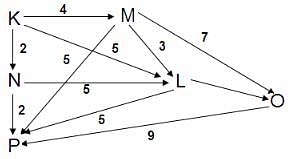
What would be the distance travelled by Priya, if she wants to travel through the path K-N-L-P?
Directions: Study the following information and answer the questions that follows.
Kiran, Piya and Amar are going to take a round of a city following different or same pathways. All of them can take any means of transportation (car, two wheeler, or public transport). Charges for all of them are different. They have to pay Rs. 200/hr, if they are taking a car on rent. While the charges for a two wheeler are Rs. 50/hr. However, they just need to pay Rs. 20 to go through a public transport for an hour. Their route will start from point K and will end at point P. O is the place where they can sit and relax. M, L and N are places to get different means of transport. M is the place where cars are parked. L is a bus stand, while at place N, two wheelers are parked. The charges of going to car parking, two wheeler parking or bus stand are fixed and are Rs. 30, Rs. 10 and Rs. 40, respectively. The different pathways are as follows and the distance between them is given in km.
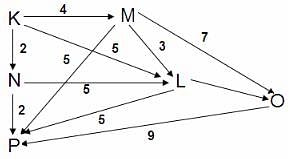
How much amount does Priya need to pay, if she first goes by a car, then by a bus and finally reaches her destination, given that she spends an hour on each vehicle?
Directions: Study the given information and answer the question that follows.
Some athletes are riding bicycles in a playground and they are at different places, which is shown in the diagram given below. Each of them has started their journey from the entry gate, which is at the start point and their final destination is the end point. It is not necessary that all of them will reach their final destination. Their direction of movement is shown with the help of an arrow. Distance between them is given in metres.
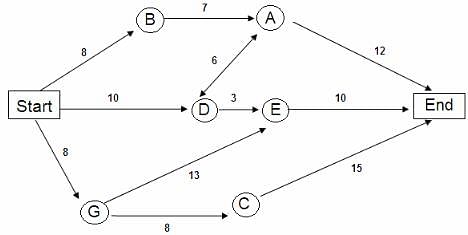
How much distance Ankit has to cover to reach point A if he can go only from uni-directional way?
Directions: Study the given information and answer the question that follows.
Some athletes are riding bicycles in a playground and they are at different places, which is shown in the diagram given below. Each of them has started their journey from the entry gate, which is at the start point and their final destination is the end point. It is not necessary that all of them will reach their final destination. Their direction of movement is shown with the help of an arrow. Distance between them is given in metres.
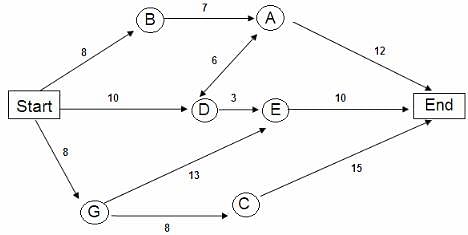
Karan, an athlete, has started from the 'start' point and is going towards point D from the shortest route. If the shortest distance between the starting point and D is reduced to half and his pathway towards A is blocked, then how much distance will have to be covered by Karan to reach its final destination?
Directions: Study the given information and answer the question that follows.
Some athletes are riding bicycles in a playground and they are at different places, which is shown in the diagram given below. Each of them has started their journey from the entry gate, which is at the start point and their final destination is the end point. It is not necessary that all of them will reach their final destination. Their direction of movement is shown with the help of an arrow. Distance between them is given in metres.
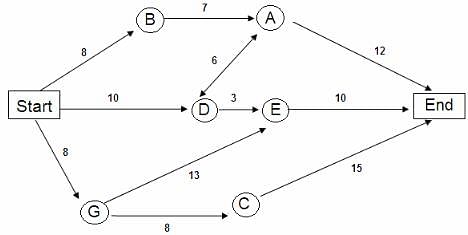
If there is one athlete standing at every place (A, B, C, D, E and G), as shown in the diagram, then how many maximum number of athletes can Ankit meet on his way from the starting point till the end point, as he has to go through place A?
Directions: Study the following information carefully and answer the question that follows.
Six levels of a game – A through F – are connected by a few two-way paths, as shown below. To travel along any path directly connecting any two ways, a person has to collect some points. In the figure below, the length of each path (in m) is indicated by the number, and the points a person can collect are written inside the square adjacent to the path. Direction of the arrow is representing the different paths they can follow.

If two players are playing a game and want to score equal points but both cannot take same route, then which routes should they follow such that the total distance covered remains more than 10 m for each of them?
Directions: Study the following information carefully and answer the question that follows.
Six levels of a game – A through F – are connected by a few two-way paths, as shown below. To travel along any path directly connecting any two ways, a person has to collect some points. In the figure below, the length of each path (in m) is indicated by the number, and the points a person can collect are written inside the square adjacent to the path. Direction of the arrow is representing the different paths they can follow.
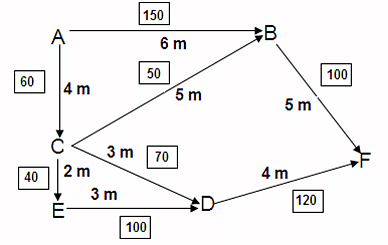
If points at all the pathways are reduced to half and distance has been doubled, then what would be the pathway between A and F with highest points but not with the shortest distance?
Directions: Study the given information and answer the question that follows.
There are different ways to travel from point K to P in a garden, where point K is the entry gate and point P is the place where rides are available. L, M, Q and S are the four other places located in the garden, and the distance between these places is shown with the help of the diagram given below. L is the point where canteen is available, while at point Q, anyone can park their vehicles (which is free of cost). Toilets are at point M, and S is the place where people can sit and enjoy music. The charges per ride are Rs. 40 and the price per eatable is Rs. 10. Persons who want to enjoy music need to pay Rs. 100 per head. Entry charges are Rs. 50 per head for adults and Rs. 20 per head for children.
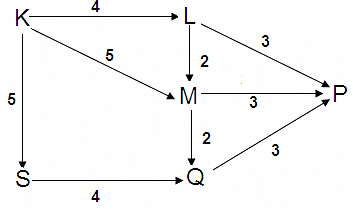
Which of the following is the shortest distance to reach point P from the entry gate?
Directions: Study the following information and answer the questions that follows.
Few friends (A, B, D, E and F) are playing ludo and their tokens (same as their names) are at different places on the board. The distances between the tokens are given in steps in the following diagram. All of the tokens will be started at green point, which is C in the following diagram, and they can cross the point C again on their way to reach at different locations.
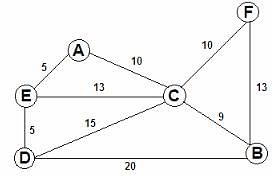
How many minimum number of steps would be required to reach point B from point E?
Directions: Study the following information and answer the questions that follows.
Few friends (A, B, D, E and F) are playing ludo and their tokens (same as their names) are at different places on the board. The distances between the tokens are given in steps in the following diagram. All of the tokens will be started at green point, which is C in the following diagram, and they can cross the point C again on their way to reach at different locations.
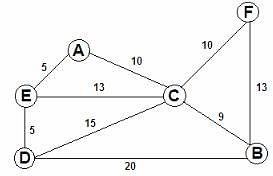
If F's final destination is point A and he has to take the longest route and can cross the point C only once, then how many total steps would be required by F?
Directions: Study the following information and answer the questions that follows.
Few friends (A, B, D, E and F) are playing ludo and their tokens (same as their names) are at different places on the board. The distances between the tokens are given in steps in the following diagram. All of the tokens will be started at green point, which is C in the following diagram, and they can cross the point C again on their way to reach at different locations.

Which of the following combinations has distance of steps more than the first multiple of 5 but less than the third multiple of 5?
Directions: Study the following information and answer the questions that follows.
Few friends (A, B, D, E and F) are playing ludo and their tokens (same as their names) are at different places on the board. The distances between the tokens are given in steps in the following diagram. All of the tokens will be started at green point, which is C in the following diagram, and they can cross the point C again on their way to reach at different locations.
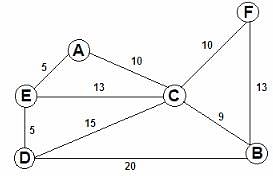
If a new person joins the game and he is at the same point as E, then how many steps would be required by him to reach B when the route taken by him is E-D-C-B?
Directions: Study the given information and answer the question that follows.
There are different ways to travel from point K to P in a garden, where point K is the entry gate and point P is the place where rides are available. L, M, Q and S are the four other places located in the garden, and the distance between these places is shown with the help of the diagram given below. L is the point where canteen is available, while at point Q, anyone can park their vehicles (which is free of cost). Toilets are at point M, and S is the place where people can sit and enjoy music. The charges per ride are Rs. 40 and the price per eatable is Rs. 10. Persons who want to enjoy music need to pay Rs. 100 per head. Entry charges are Rs. 50 per head for adults and Rs. 20 per head for children.
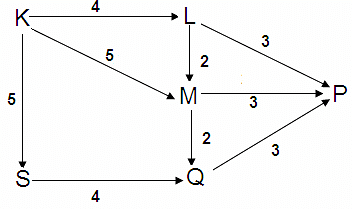
How much does an adult need to pay by taking the longest route possible (in distance) if he wants to travel from the entry gate till the parking and wants to enjoy everything on his way?
Directions: Study the given information and answer the question that follows.
There are different ways to travel from point K to P in a garden, where point K is the entry gate and point P is the place where rides are available. L, M, Q and S are the four other places located in the garden, and the distance between these places is shown with the help of the diagram given below. L is the point where canteen is available, while at point Q, anyone can park their vehicles (which is free of cost). Toilets are at point M, and S is the place where people can sit and enjoy music. The charges per ride are Rs. 40 and the price per eatable is Rs. 10. Persons who want to enjoy music need to pay Rs. 100 per head. Entry charges are Rs. 50 per head for adults and Rs. 20 per head for children.

How much distance will Arun have to cover if he first wants to go from the entry gate to the music hall, then to parking, and at last for rides?
|
5 docs|272 tests
|

















